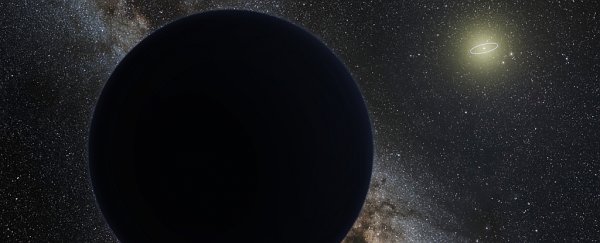If Planet Nine is out there, a large, mysterious planet lurking at the dark edges of the Solar System, it may not be where we thought it might be.
According to astronomers searching for the hypothetical object, new information taken into account could mean that its orbit is significantly more elliptical than most recently predicted.
The hypothetical Planet Nine made a big entrance in 2016, when astronomers Konstantin Batygin and Michael Brown of Caltech published a paper in The Astronomical Journal. In it, they set out their case for an as-yet undiscovered planet in the outer reaches of the Solar System. The evidence, they said, lay in other objects from far beyond the orbit of Neptune.
These objects are called Extreme Trans-Neptunian Objects (ETNOs). They have huge elliptical orbits, never crossing closer to the Sun than Neptune's orbit at 30 astronomical units, and swinging out farther than 150 astronomical units.
Batygin and Brown found that these orbits have the same angle at perihelion, the point in their orbit that is closest to the Sun. The astronomers ran a series of simulations, and found that the gravitational influence of a large planet could cluster the orbits in this way.
Since that paper dropped, the theory has become very controversial, with many astronomers finding Planet Nine's existence unlikely, but so far we have no firm evidence one way or the other. The most conclusive way the debate will be settled is if we find the slippery thing - and a new update from Batygin and Brown could help us try to do that.
Their new paper has been accepted into The Astrophysical Journal Letters, and is available on preprint server arXiv.
The initial detection of a possible Planet Nine back in 2016 was made based on just six ETNOs - these objects are, after all, very small, and very hard to detect. Over time, more ETNOs have been discovered - today we know about 19 - which means we now have more data to analyze to calculate the characteristics of the planet.
In 2019, the astronomers revised the available information and came to the conclusion that they had gotten a few things slightly incorrect. The mass of the planet, according to the revision, was only five times the mass of Earth, rather than the 10 they had initially calculated, and its eccentricity - how elliptical it is - was lower.
And now they've updated those calculations again.
"However," they wrote in a post on the Find Planet Nine blog, "the question we asked ourselves during the height of the pandemic is a different one: are essential physics missing from our simulations? Through our continued and incessant probing of the model, we have discovered that the answer to this question is 'yes'."
Their simulations, they said, assumed that any object that moves beyond 10,000 astronomical units from the Sun is lost to space. What they weren't taking into account was that the Sun wasn't born in isolation, but probably in a large, heavily populated star-forming cloud with other baby stars.
Under these conditions, the baby Solar System would have almost definitely formed an inner section of the Oort Cloud, the shell of icy bodies surrounding the Solar System between about 2,000 and 100,000 astronomical units from the Sun. The formation of giant planets such as Saturn and Jupiter would have flung debris outwards towards interstellar space; but the gravitational perturbations of passing stars would have pushed them back into the Sun's gravitational influence, so that they end up forming the inner Oort Cloud.
We tend to think of the Oort Cloud as just sort of hanging about, not doing much of anything, really, but when Batygin and Brown ran a whole bunch of new simulations, taking these physics into account, they found that objects in the inner region of the Oort Cloud may indeed move about a bit.
"Planet Nine, however, alters this picture on a qualitative level," the researchers said.
"Due to the long-term gravitational pull of Planet Nine's orbit, inner Oort Cloud objects evolve on billion-year timescales, slowly getting re-injected into the outer solar system. So what happens to them? We have simulated this process, accounting for perturbations from the canonical giant planets, Planet Nine, passing stars, as well as the galactic tide, and have found that these re-injected inner Oort Cloud objects can readily mix in with the census of distant Kuiper belt objects, and even exhibit orbital clustering."
This means that some of the extreme trans-Neptunian objects we have found could in fact have originated in the Oort Cloud, which is really cool. However, the team's simulations also showed that the clustering of the Oort Cloud objects would be weaker than that of the objects that came from the Kuiper Belt, closer in.
This suggests that a more eccentric orbit for Planet Nine would better explain the data than the orbit the researchers' 2019 paper found.
We won't know exactly how eccentric that orbit might be until more study can be conducted of the clustered objects, to determine which of them originated in the inner Oort Cloud; but, there's a limit to how eccentric the orbit can become before it is no longer consistent with our observations of the outer Solar System.
Because the hypothetical planet is so far away and so dim, our chances of spotting it are really low, so this information can be used to refine models, and stop us looking for it in places it might not be - hopefully leading to a detection of this elusive beast.
Even if we never find it, though, the discoveries it has led to have been awesome. A whole bunch of new Jovian moons and super-distant potential dwarf planets is nothing to sneeze at.
Batygin and Brown's new paper has been accepted into The Astrophysical Journal Letters, and is available on arXiv.
